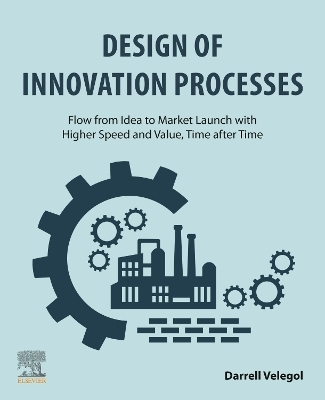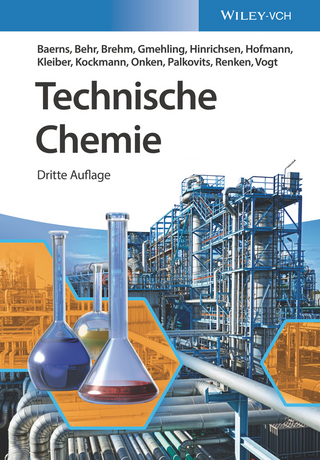
Design of Innovation Processes
Elsevier - Health Sciences Division (Verlag)
978-0-323-90465-0 (ISBN)
The author, Dr. Darrell Velegol, Distinguished Professor of Chemical Engineering at Penn State University, sees ineffective innovation processes as the reason why chemical process industries are growing less than industries like digitech, hence he provides valuable information in this updated resource.
Info to be populated in this space Darrell Velegol attended West Virginia University for his BS in Chemical Engineering, and he earned his PhD in Chemical Engineering at Carnegie Mellon University in 1997 working with Professors John L. Anderson and Stephen Garoff. In 1998 Velegol won the Victor K. LaMer Award of the American Chemical Society for the best PhD in the field of Colloid & Surface Science. He continued with a post-doc in the Center for Light Microscope Imaging and Biotechnology at Carnegie Mellon, working under Professor Fred Lanni of the Biology Department. In June 1999 Velegol joined the Department of Chemical Engineering at Penn State, where he was promoted to Associate Professor in 2005. Velegol won an NSF CAREER Award in 2000, and has continued to be funded by NSF, DOE, EPA, PRF, the Air Force, and other organizations for his work with colloidal systems, including forces and stability, directed assembly, electrokinetic flows, colloidal motors, and chemically-driven transport. His research group uses a wide range of experimental and modeling approaches. In 2009 Velegol was promoted to Full Professor at Penn State. He has won numerous teaching and research awards, and he served as ABET accreditation coordinator in his department over many years. For his research in experimental and theoretical problems in the dynamics of complex colloidal particles, Velegol was elected a Fellow of the American Association for the Advancement of Science (AAAS) in 2011 and appointed as a Distinguished Professor at Penn State in 2012. He is a member of ACS, AIChE, AEA, AAAS, and ASEE. In part of his research, he conducts value-creating studies in colloidal systems. His expertise lies in chemically-driven transport (e.g., diffusiophoresis due to salt gradients and chemical gradients), colloidal motors (i.e., self-swimming particles), colloidal forces (e.g., van der Waals, electrostatic), nanoparticle stability and transport, and colloidal assembly fabrication (e.g., by particle lithography, or stimulate-quench-fuse methods). His research requires fundamental studies in colloidal forces, electrokinetic flow modeling, and instabilities in sedimentation operations. His lab group combines experiments (e.g., video microscopy, confocal microscopy, electron microscopy, Nanofabrication, synthesis, zeta potentials), numerics (e.g., Brownian dynamics simulations, eigenmode problems), and theory (e.g., hydrodynamics, electrokinetics, colloidal forces, mass transfer). More recently, he has started to develop Econochemistry and “chemical game theory, a re-framing of classical game theory (e.g., from Economics and Political Science) which involves using chemical engineering principles to examine questions in collective decision making, power, trust and deception, and dialogue. He teaches a Chemical Engineering technical course CHE 444 in this new field. From Fall 2013 through the present, he has co-taught a MOOC called “Creativity, Innovation, and Change, which has enrolled over 250,000 students from over 190 nations, among the 25 largest ever. And he has published numerous books, including “Wild Scholars in 2011 about education, “CENTER in 2013 about imagining great dreams and winning great victories, “Physics of Community in 2015 about chemical game theory and decision making, and most recently “Colloidal Systems in 2016 about technical fundamentals of colloid science. His goal at Penn State is to mentor students to imagine great dreams and win great victories. In 2017 he started the Knowlecular Processes Company, in order to extend both the technical and team ideas into industry, in order to increase the value and speed of research, engineering, and decision making. The aim is to help companies become the smartest innovators in their industry.
1. Overview. A day in the life of innovation transformation
PROBLEM AND PROMISE2. Growth is slow in the CPI. Dow 30, pharma IRR < CoC (NYU Stern table), Doorley growth table3. Stage Gate methods lead to low growth. Explain challenges of Stage Gate4. The Profit Equation gives levers for innovation throughput. The 5 variables. Full and simple versions. Plot. Example
PHILOSOPHY AND PROCESSES5. Central philosophy is innovation as type of process manufacturing6. Products of manufacturing. Innovation comes from FVoC, IIT, VQs-MHs7. PFD of Innovation Processes. Explanation of essential pieces8. Common bottlenecks in your process
PRACTICES9. FVoC. Jobs to be done. How far ahead? Surviving Amazon10. IIT. How to plant, grow, and nurture your Integrated Innovation Team11. Ideation. Methods for generating ideas for the FVoC11. VQs-MHs. Asking Valuable Questions, creating Multiple Hypotheses to evaluate risks13. Goal setting. Vectorization requires fewer projects in the portfolio. Analysis of lag times14. Valuation. Using Delphi method for valuating future projects. Assessing value for R&D and by function15. Deliberate learning. Importance, sources, experts16. Adaptive Execution. Best methods in project management. Include Goldratt, Scrum17. Monday morning. Places to start
APPENDICESAppendix A. NYU-Stern Cost of Capital (CoC).Appendix B. Investment equation for optimal innovation investment. Schott paper. Analysis of industriesAppendix C. Knowlecular perspective. Include trust as a knowlecular conceptAppendix D. Dow-30 over the decades
| Erscheinungsdatum | 26.08.2023 |
|---|---|
| Verlagsort | Philadelphia |
| Sprache | englisch |
| Maße | 152 x 229 mm |
| Gewicht | 390 g |
| Themenwelt | Naturwissenschaften ► Chemie ► Technische Chemie |
| Technik | |
| Wirtschaft ► Betriebswirtschaft / Management ► Unternehmensführung / Management | |
| ISBN-10 | 0-323-90465-3 / 0323904653 |
| ISBN-13 | 978-0-323-90465-0 / 9780323904650 |
| Zustand | Neuware |
| Informationen gemäß Produktsicherheitsverordnung (GPSR) | |
| Haben Sie eine Frage zum Produkt? |
aus dem Bereich


